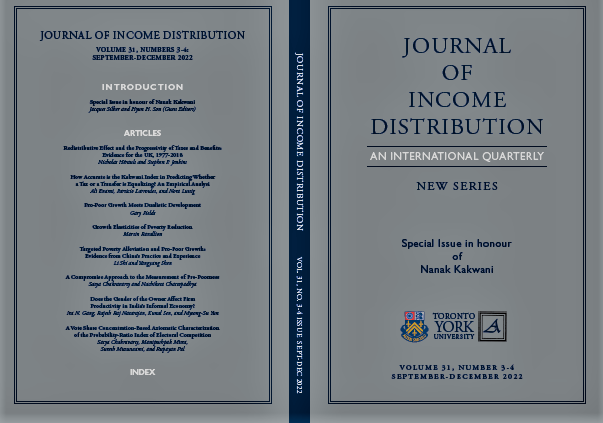A Vote-Share Concentration-Based Axiomatic Characterisation of the Probability-Ratio Index of Electoral Competition
DOI:
https://doi.org/10.25071/1874-6322.40549Keywords:
Electoral competition, probability ratio index, concentration, consistency in aggregation, competitive indifferenceAbstract
We axiomatically characterise the probability-ratio index of electoral
competition, which is based on the vote shares of parties competing in an
election. It is the ratio between the probabilities that two voters drawn at
random with (without) replacement voted for different parties under actual
vote shares across the competing parties and under equal vote shares across
them. This vote-share concentration-based measure is characterised using
two simple axioms, consistency in aggregation and competitive indifference.
The former expresses the index as a weighted sum of competitiveness in
two-party elections. The latter is concerned with the redistribution of vote
shares across parties.
References
Capron, H., and J-L. Kruseman 1988 “Is political rivalry an incentive to vote?”, Public Choice 56(1): 31–43.
Chakravarty, S., M. Mitra, S. Mutuswami, and R. Pal 2020 “On the probability ratio index as a measure of electoral competition”, Palgrave Communications 6(96): 1–6.
Chakravarty, S. R., and J. A. Weymark 1988 “Axiomatizations of the entropy numbers equivalent index of industrial concentration” in W. Eichhorn (ed.), Measurement in Economics Heidelberg: Physica.
Dalton, H. 1920 “The measurement of the inequality of incomes”, Economic Journal 30(119): 348–361.
Donaldson, D., and J. A. Weymark 1980 “A single-parameter generalization of the Gini indices of inequality”, Journal of Economic Theory 22(1): 67–86.
Endersby, J., S. Galatas, and C. Rackaway 2002 “Closeness counts in Canada: voter participation in the 1993 and 1997 federal elections”, Journal of Politics 64(2): 610–631.
Fleurbaey, M. and F. Maniquet 2011 A theory of fairness and social welfare Cambridge: Cambridge University Press.
Foster, J. E., J. Greer, and E. Thorbecke 1984 “A class of decomposable poverty measures”, Econometrica 52(3): 761–766.
Jones, M. A. 2020 “A Difference Equation Approach to Finite Differences of Polynomials”, The College Mathematics Journal 51(5): 375–377.
Kakwani, N., A. Wagstaff, and E. vanDoorslaeff 1997 “Socioeconomic inequalities in health: Measurement, computation, and statistical inference”, Journal of Econometrics 77(1): 87–103.
Kirchgassner, G., and A. Meyer zu Himmern 1997 “Expected closeness and turnout: An empirical analysis of the German general elections, 1983–1994”, Public Choice 91(1): 3–25.
Kirchgassner, G., and J. Schimmelpfennig 1992 “Closeness counts if it matters for electoral victory: Some empirical results for the United Kingdom and the Federal Republic of Germany”, Public Choice 73: 283–299.
Laakso, M., and R. Taagepera 1979 “‘Effective’ number of parties: A measure with application to West Europe”, Comparative Political Studies 12(1): 3–27.
Mayhew, D. 1974 “Congressional elections: The case of the vanishing marginals”, Polity 6(3): 295–317.
Moulin, H. 2004 Fair division and collective welfare, Cambridge, Massachusetts: The MIT Press.
Ucieklak-Jeż, P. 2018 “Income and Education as a Source of Health Inequality. New EU Countries Case”, Research Papers of Wrocaw University of Economics 181–192.





